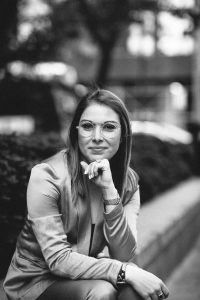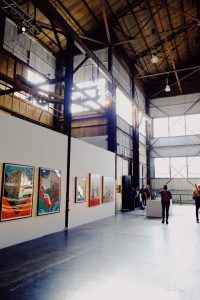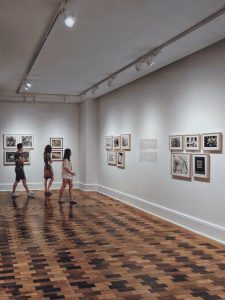It’s More Than Monet or Matisse: Art and Public Relations
Published on December 6, 2019, at 1:45 p.m.
by Carlyle Ascik.
Whether it’s a world-renowned artist setting up her latest museum exhibition, or a self-starter hoping to auction off his first piece at a small gallery — public relations professionals play a critical role in the art community. They draw the public into local museums, linger at gallery openings to craft the perfect story and skillfully pitch newsworthy pieces to the proper outlets. They work closely with donors, collectors and artists alike.

Ellie Hayworth is the founder of the Hayworth Company — “a strategic communications consultancy committed to promoting intrepid ideas in the arts.” Located in New York City, she works with director.with the contemporary artist, Suzy Kellems Dominik, in addition to a number of galleries, non-profits, design companies, auction houses and other arts entities, essentially as their extended public relations director.
Sonya Wierzowiecki is a Texas native who has served in public relations roles at the Kimbell Art Museum and the Modern Art Museum of Fort Worth. She is currently the manager of special events and membership at the Modern where she works primarily on member programs.
While these public relations professionals live over 1,500 miles apart and function in largely different roles each day, they only begin to represent the variety of positions that can be found in a career in the arts. Recently, they shared through the following Q&A how they broke into the industry, their day-to-day practices and what advice they have for individuals hoping to work with fine arts.
Q: Did you always know you wanted to work in public relations for the arts?
Ellie: “The short answer is no. I started my career in college with a double major in communication studies and art history, and my goal was to either work at an art advisory firm or become a collection manager. I am very taken by working with living artists, so I decided to go down that path and pursued a master’s in art business at Sotheby’s Institute in New York City. I was exposed to an art tech startup pretty early on there. … I got on board in the context of marketing and communications and quickly realized that a lot of the skills it took to help collectors build their collections were actually communications and PR based. From there, I ended up pursuing a job with an amazing agency where I learned a lot of my early insights.”
Sonya: “I have always had an interest in art — I grew up taking every art class I could and visiting local museums with my mom. At school, I double majored in strategic communications and journalism. … When I graduated, I was looking for the type of job where I could leave work at work, so I could do some freelancing on the side, and the museum industry definitely allows for that. When I graduated I saw a position open in PR at the Kimbell Art Museum. The director of marketing, who hired me, majored in studio art and marketing. She had a very strong art history background and I was able to bring fresh media contacts to the position from my work in journalism during college. Together we made an ideal team because I was able to approach PR for the museum as a general visitor. Not being an art scholar, I always try to consider how can I turn the exhibitions into something that visitors who may not know much about art outside of Picasso or Monet would still be interested in.”

Q: How has the art industry changed over the scope of your career?
Ellie: “I think that relationships have shifted significantly because of digital media, social media and the rate at which people are consuming information online. When I started my career, print was still a very viable media channel. That is not to say that there aren’t still some really amazing print publications, but what we are finding is that channels such as influencer marketing, social media, email campaigns and content marketing are all things that are becoming more efficient, effective and salient in the industry.”
Q: What does your day-to-day look like?
Ellie: “My day-to-day probably changes day to day. First thing in the morning — over a cup of tea if you will — I like to do a lay of the land of the media landscape. I try to read The New York Times, The Wall Street Journal and some of the art trades. ART News, for instance, sends out a really wonderfully curated news digest every day called Breakfast with ART News. So I literally have breakfast with ART News every morning. From there I usually have client meetings — some of those are taken in the house, but a lot of the time I meet them on-site, which makes for a really fun dynamic. Just to give you an idea, I have an event tonight, we are overseeing an event tomorrow night, we have another event on Saturday, and then an exhibition opening on Wednesday. So at any given point, I am also managing RSVPs, sending out pitches and identifying programmatic partners.”
Sonya: “My current job at the Modern Art Museum is in membership and special events. I always tell people I am the friend maker and party planner for the museum. We usually have around 65 membership programs per year and those are for members of all levels so they can be very different. When I started out, I was in a very traditional PR role, so I frequently worked with the media to get our story out there to the public. Now my job is more about fostering a connection and sharing our story on a more personal level with one-on-one connections. I also maintain a portfolio of donors who give $1,500 or more to the museum. With that, I solicit corporate sponsorships and create community partnerships that I think would be a good fit for certain events.”
Q: Who is your favorite artist you have worked with?
Sonya: “Kaws” was so great to work with especially because he was extremely generous to the museum. He created a custom toy that we were able to release at the Modern and take home the proceeds on. You wouldn’t expect a lot of artists at his level to notice the little guy, but at his opening dinner, he came back in and introduced himself to me — as if I didn’t know who he was — and thanked me for my work on his exhibit. He was so cordial and genuine, and that was such a neat experience for me because oftentimes my role is very behind the scenes.”

Q: What is your best advice for people interested in breaking into this industry?
Ellie: “Read and stay really closely apprised to the media landscape — subscribe to newsletters, listen to podcasts and don’t be afraid to form your own opinions. You don’t have to like every campaign you see, and you don’t have to love all of the artists you meet, and I think that developing that kind of professional discretion is super valuable.”
Sonya: “Scour museum career pages and try your best to get an internship while you are a student. If an internship isn’t available, perhaps there is a volunteer position, or really anything you can do to get your foot in the door and experience what it is like day to day in a museum. The museum world is vast but very small. You know who the movers and shakers are in the art world, so breaking in is a huge step.”




